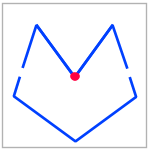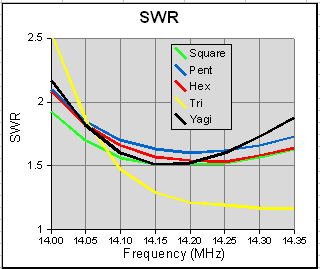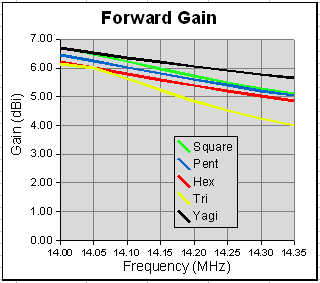Introduction And Conclusions top
An experimental antenna similar to the TAK spiral antenna was evaluated for SWR response
over the frequency range of 7.0 to 7.3 MHz, or the 40-meter band.
Summary of results
- Beam length has a significant effect on SWR response. Increasing the distance
between spirals increases the antenna's resonant frequency. Beam length can be used
to fine-tune a spiral antenna to the desired resonant frequency. - The combined length of antenna and hookup wire has a significant
effect on the antenna's resonant frequency. The longer the combination, the lower the
resonant frequency. - The diameter of a spiral antenna affects its bandwidth, as measured by the frequency
range where the SWR is equal to or less than a value of 2. Increasing spiral diameter
increases bandwidth.
TAK markets and sells a 40-meter antenna that is a unique arrangement of a simple dipole
where the quarter wave sections are wound into flat spirals instead of being arranged in
a straight line. The advantage of this configuration lies mainly in its compact size. The
finished antenna easily fits into a 3-foot cube.

TAK Antenna
George Mann, the president of the Lakeland Radio Amateurs Club was kind enough to let me
study his TAK antenna. For this experiment the TAK's major drawback was its fixed length
beam. An easy to construct design that overcame this shortcoming was needed.
Materials used to construct an adjustable length beam antenna are available at any home
center and consist mainly of PVC electrical conduit, and two sizes of PVC water pipe.
Fourteen-gauge aluminum wire was chosen for the antenna because of its low cost.
Design and Construction Of An Adjustable Beam Spiral Antenna top
Construction consisted mainly in cutting PVC to length and drilling holes. A modified spade
bit, ground to the diameter of the gray PVC conduit used for the cross arms, was used to
drill holes in the movable sections of the beam. To insure that the holes were at right
angles to each other, a simple jig was used to hold the beam member during the drilling
operation.

Drilling Jig
The image above shows the jig in use during the drilling operation. After the first pair
of through-holes are drilled, a piece of scrap PVC is inserted through these holes, and
the piece is then returned to the jig with the scrap PVC now resting on the locating rails.
This insures that the next pair of holes in the PVC will be at right angles to the first pair.

One Of Two End Sections
In the above photo, the larger diameter PVC has been drilled and the spiral arms inserted.
The two cross members are secured with a single self-tapping screw.

Arm Attachment

Adjustable Beam Length
In contrast with the TAK, the beam in this design is not one but three pieces. Two hold
the spiral supporting arms, while the third, smaller in diameter section, fits into the
other two. This arrangement produces an adjustable beam. The above image shows how one
section slides over the other, in trombone fashion, allowing for the beam length to be
varied.
Spiral Antenna Design top
The primary spiral antenna design parameters are: the desired resonant frequency, the
length of the hook up wire that connect the antenna to the coax, and the minimum distance
the antenna wire is allowed to come to the end of any one PVC support arms. Once these
parameters have been determined, many spiral designs are possible by varying the spiral
pitch, or distance between turns, and the starting distance from the hub of the spiral.
From a mechanical perspective the most important design consideration is how close the
outermost end of the antenna wire comes to its supporting spoke. An antenna wire that is
an inch too short will leave a large section of antenna wire unsupported, whereas one
that is an inch or two longer than needed to reach the last support is easily tolerated,
and may even be an advantage in subsequent tuning. Therefore, it is important to choose
pitch and start values with this in mind.
Calculating the effects of starting distance and pitch on a known length of wire can be
tedious, and finding the combination that satisfies the condition that the wire reach the
last spoke with little or no overhang can be daunting. To address these concerns a spiral
antenna spreadsheet model was created to do the calculations for the designer.
For clarity the spreadsheet begins with a graphic showing the spiral antenna's most important
parameters which are: start point, pitch, safe edge, spoke length, and arm length.

A table of inputs and outputs follows the diagram. Inputs are in peach, outputs are in
yellow colored cells. The designer enters the desired frequency, the length of hookup
wire, assumed velocity factor, and safe edge. In response, the spreadsheet calculates
the required length of antenna wire in both inches as well as feet and inches. The
spreadsheet does its calculations in inches, but the user will find the conversion to
feet and inches more practical when cutting wire to length.
Of the remaining two boxes, one is labeled pitch, or the distance between turns, and the
other is labeled start, or the distance from the hub to the point on spoke R1 where the
antenna will start. Adjacent to these two inputs are two outputs labeled turns and min
spoke. The significance of turns is that values ending in 0, .25, .5, or .75 signify that
the end of the outermost lap of wire just reaches a spoke. A value not ending in one of
the above fractions means that the antenna wire will end between spokes. As mentioned
above, a little over is much more desirable than a little under.
Minimum spoke determines the overall size of the antenna. In fact the diameter of the
antenna will be twice this value. The length of the cross arms will be twice the sum of
the min spoke plus the safe edge.

The overall antenna diameter is calculated as values for pitch and start are entered. The
same is true for the overall arm length, the measurement needed to cut the support arms to
proper length.
Kerfs, or saw cuts made in the PVC support arms, in combination with plastic wire-ties,
are used retain the antenna wire. The spreadsheet creates a kerf cutting table based on
the pitch and start values entered. In practice two cross arms are placed at right angles
to each other forming a plus sign. Then in either clockwise or counter clockwise fashion,
spokes are labeled R1 through R4. The center is marked on each arm, and the table values
are then transfered to each spoke, starting at the center of each arm and working out to
the end.
The Effect Of Beam Length On SWR top
(Note: all SWR measurements were made using the MFJ Model xxx antenna analyzer. In each
case the test antenna was raised thirteen feet above the ground and connected to the
analyzer through approximately 60 feet of RG8 mini coax.)
The following graph shows the result of beam length on SWR. It is clear from these data
that as the beam is lengthened, or the spirals are moved farther apart, the resonant
frequency is increased. In this experiment the separation was varied from 27 to 37 inches in
two-inch increments. Over this distance the resonant frequency shifted approximately .18 MHz
or just over half the 40-meter bandwidth.

SWR vs Separation
The Effect of Spiral Diameter On Bandwidth top
Spiral diameter has an effect on bandwidth. Two antennas were compared, one with a 32-inch
diameter spiral, and another with a 48-inch diameter spiral. Tracing along the line equal
to an SWR of 2 the bandwidths of each variation can be compared. In this experiment the
frequency range at or below an SWR of 2 was much greater for the 48-inch model than for
the 32-inch model. The two horizontal lines at the bottom of the chart represent this
difference and are equal in length to the bandwidths of the 32 and 48-inch antennas
respectively. See figure below.

Comparison of 32 vs. 48-Inch Arm Length
Model Verification - Does the model work? top
A model is only as good as the results it produces. To test the validity of the spiral
antenna model an antenna was constructed according to the following parameters. See
table below. After selecting the resonant frequency, hookup wire length, and velocity factor,
pitch and start values were varied to produce an antenna with a slight overhang past its
last supporting point. This is one of many configurations that could have been selected.

The exact length predicted by the model was marked on a length of 14-gauge aluminum wire.
The wire was then cut a few inches longer than required. Next, two spirals were wound
according to the table above. The model predicts that there will be 6.06 revolutions. The
additional .06 revolutions amounts to 21.6 degrees and equates to an approximate distance
along the outermost lap of this spiral design of 5.8 inches. The average overhang for both
test spirals was just over an inch less than the theoretical value. This discrepancy can
easily be accounted for by construction technique.
After attaching the spirals to a beam, a series of SWR tests were made. In each case the
antenna was connected to 60 foot of RG8 mini and elevated 13 feet above the ground. The
antenna wire length was intentionally set long to insure that it would not be necessary
to add extra wire in the tuning process. Consequently, initial SWR measurements suggested
that the resonance point was low. Material was removed from the outer lap of each spiral
until the exact length of antenna wire determined by the model was reached. At that
condition the resonant frequency was 7.075 MHz. The aim was 7.15MHz. After two additional
inches of antenna wire were removed from the outermost lap of each spiral, the resonant
frequency increased to 7.096 MHz. Beam length was then increased by 4 inches to arrive
at a final spiral separation of 28.75 inches. This brought the resonant frequency to 7.17 MHz,
slightly above aim and favoring the voice portion of the 40-meter band.
The following graphic shows the SWR response as a function of frequency before and after
the final length adjustment. After adjustment, the SWR vs. Frequency curve can be seen to
shift to the right.

Extending the beam shifts the curve to the right.
Summary top
The spiral antenna spreadsheet model accurately predicts the number of revolutions expected
for a given antenna length, pitch, and starting distance from the center of the spiral.
The spiral spreadsheet model has proved to be a useful tool for designing and building spiral
antennas for the 40-meter band.
Future Work top
There are many possibilities for future investigation. Some suggestions are:
- The effect of wire gauge on SWR and bandwidth.
- Directional properties of the spiral antenna.
- The inclusion of a calculator within this web page
Read more...








































 A systematic approach was taken to "optimise" the wire dimensions for 20m versions of the four antennas:
A systematic approach was taken to "optimise" the wire dimensions for 20m versions of the four antennas:

 Observations
Observations